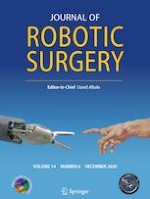Erschienen in:

20.07.2020 | COVID-19 | Brief Communication
Zur Zeit gratis
Robotic surgery during the COVID pandemic: why now and why for the future
verfasst von:
Gaby N. Moawad, Sara Rahman, Martin A. Martino, Jordan S. Klebanoff
Erschienen in:
Journal of Robotic Surgery
|
Ausgabe 6/2020
Einloggen, um Zugang zu erhalten
Abstract
Health care has changed in unprecedented ways since the first reported cases of COVID-19. With global case rates continuing to rise and government restrictions beginning to loosen, many worry that a second wave in our future. In many hospitals around the world, non-emergent surgeries were put on hold as hospitals were transformed into COVID centers. As surgeons and administrators do their best to reinstate non-emergent procedures, guidance is sought from any and all reliable sources. Robotic surgery has many known and demonstrated benefits over open surgery and often over conventional laparoscopy. In this commentary, we aim to highlight some of the advantages robotic surgery may offer during this uniquely challenging time in health care.